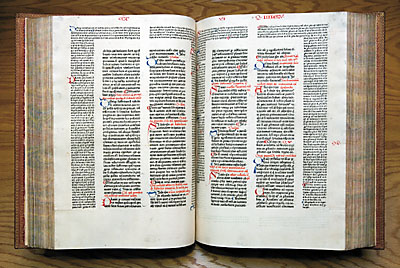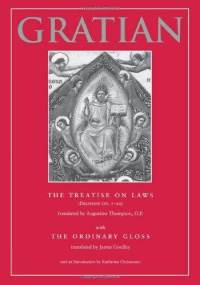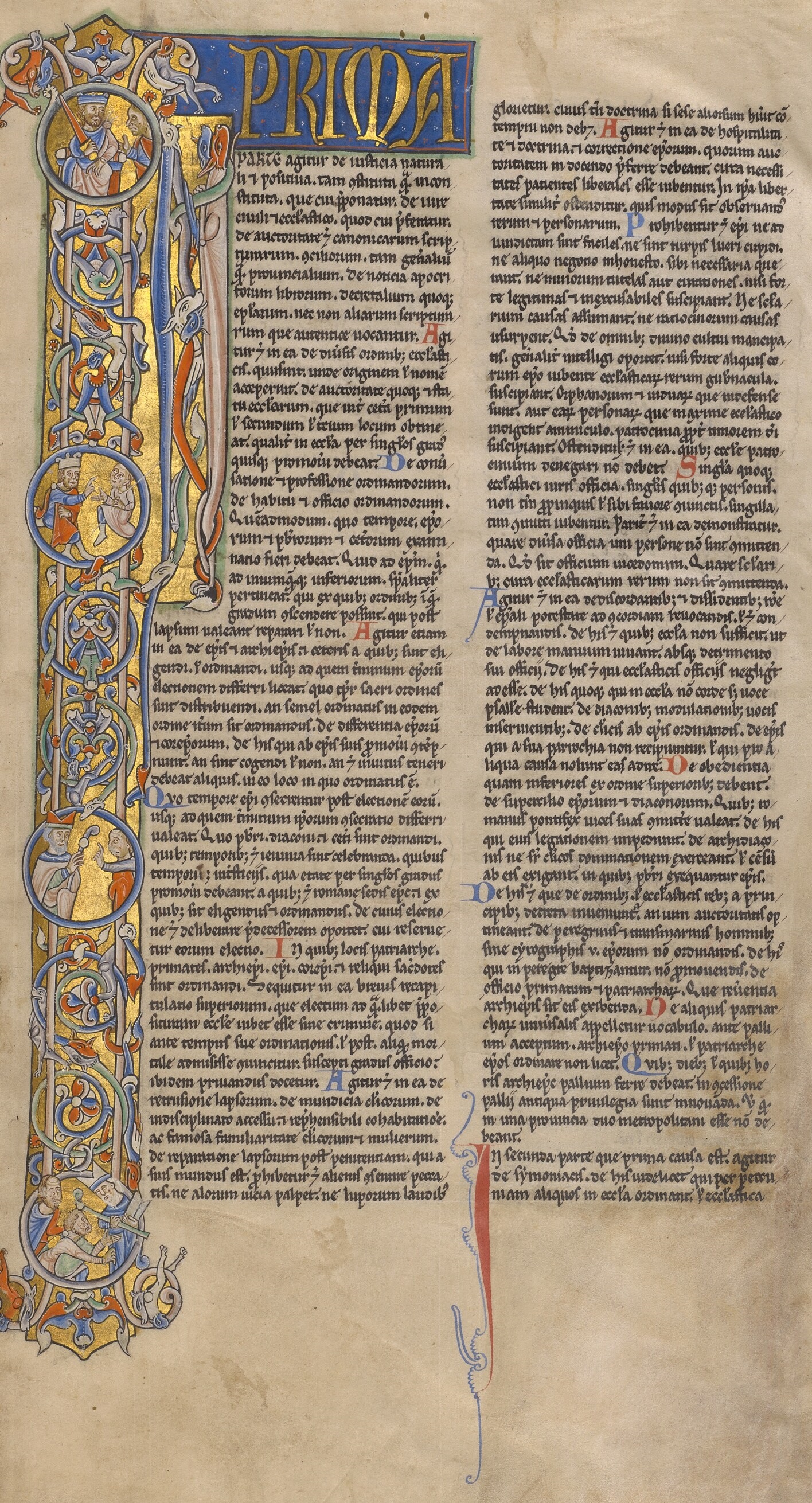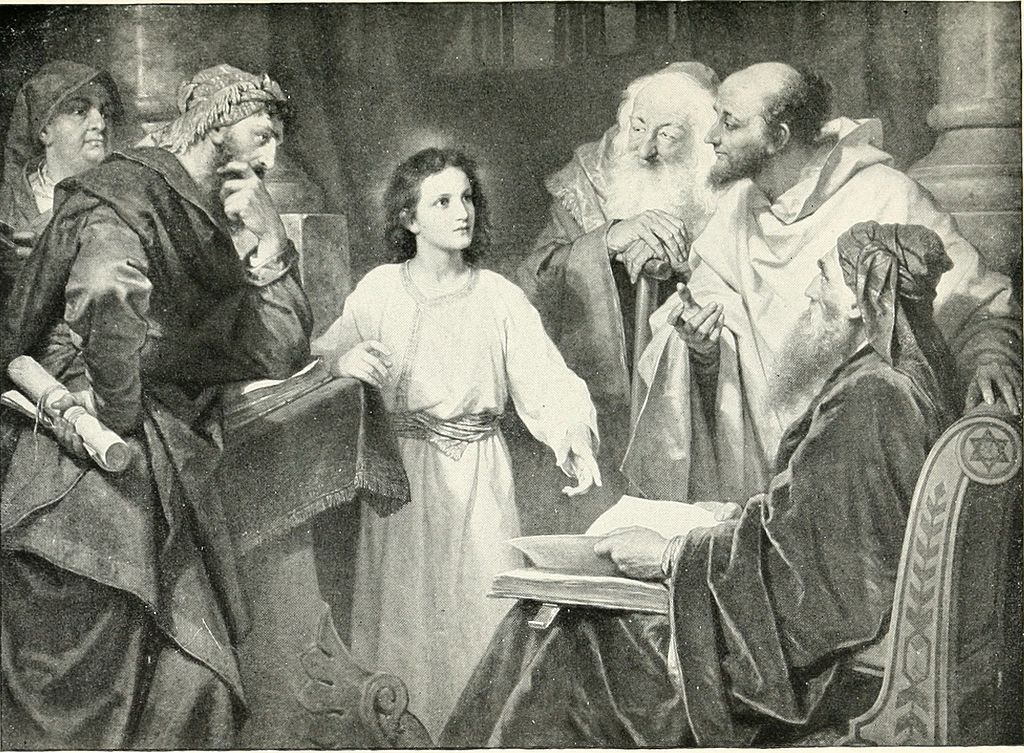| To work for the proper implementation of canon law is to play an extraordinarily constructive role in continuing the redemptive mission of Christ. Pope John Paul II |
|
8 nov 2024 |
Research links
| Canonical & Roman Legal History, here.
Ius Antiquum, here.
Corpus Iuris Canonici, here.
Ius Decretalium, here. |
| Overview
| Master Page on Gratian and his Concordia (c. 1140)
Gratian is honored as the "Father of Canon Law" because his masterwork, the Concordia or 'Decretum', was a watershed in canonistics, bringing to a close the thousand-year period of canon law known as the Ius Antiquum and launching a nearly 900-year period wherein great canonical collections (some private, some official) dominated the field. This page orients students to Gratian and his monumental work, organizes some basic materials useful toward their study, and tracks a few small decretist projects of my own.
|
| Background
The terms "Concordia" and 'Decretum' are used without distinction in Gratian studies, even by me, who prefers Concordia. |
|
| Editio typica
Volume II of Friedberg's work (the Pars Secunda) contains the rest of the Corpus Iuris Canonici. |
In 1582 the "Roman Correctors", prelates and scholars working under papal sponsorship, published their edition of the Corpus Iuris Canonici, notably Gratian's Concordia and its ordinary gloss. It is available through UCLA, here. The Correctors' text was designed for practical use and did not pretend to critical accuracy for, as Friedberg put it, the Correctors did not intend to restore the Decretum "to what had been composed by Gratian but rather to how Gratian should have composed it". Friedberg's edition carefully notes the variations between the text he settled on and the version produced by the Roman Correctors.
|
| Organization and citation of the Decretum
| Gratian's Concordia is divided into three parts:
• Part One (356 columns in Friedberg) is organized under 101 "Distinctions", most of which distinctions are subdivided into "canons". Citations to this information were traditionally provided, however, in reverse order, so that "c. 7, D. I" meant "canon 7 of Distinction I (of Part One of Gratian's Decree)".
• Part Two (835 columns in Friedberg) is organized under 36 "Cases", most of which cases are divided into "questions", most of which questions in turn contain one or more "canons". This information was also cited counter-intuitively, so that "c. 1, C. I, q. 1" meant "canon 1 of question 1 in Case 1 (of Part Two of Gratian's Decree)".
• Part Three (146 columns in Friedberg) is organized under 5 "Distinctions", all of which distinctions contain at least some "canons". Potential confusion owing to the fact that abbreviation letter "D" had been used above for "Distinction" was eliminated by the addition of "de cons" (or a closely related version thereof), short for "de consecratione", the general title of the third part, to all of its citations. Predictably then, "c. 1, D. I, de cons." meant "canon 1 of Distinction 1 of De consecratione (of Part Three of Gratian's Decree)."
A few oddities might yet confuse one in tracking Gratian citations:
• The letter "c." stands for "canon" in Gratian but for "chapter" in the rest of Corpus Iuris Canonici.
• The one-line summaries that precede nearly every canon (in Friedberg they appear in italics) were probably not penned by Gratian but by first generation users of his work.
• The very lengthy Question 3 in Cause 33 is divided into "Distinctions" which are in turn divided into "canons". It is also not called "Question 3 of Cause 33" but rather, "de poenit." short for "de poenitentia". Thus, "c. 6, D. I., de poenit." means "canon 6 of Distinction I of Question 3 of Cause 33 (of Part Two of Gratian's Decree)".
• The Roman numeral letter "X" for number 10 can be confused with a very common abbreviation for the second part of the Corpus Iuris Canonici, the Liber Extra, and, on occasion in manuscripts, even for the name of "Christ".
|
| Early Commentary on the Concordia
Some other Decretists, here.
| Commentary on the Concordia began almost immediately upon its appearance. Besides the Ordinary Gloss, typically included in printings of the Decretum itself, among the most notable early works of the "decretists" are:
• Paucapalea, identity unknown, writing around 1150. See J. von Schulte, ed., Die Summa des Paucapalea über das Decretum Gratiani [1150s], (Emil Roth, 1890) xxiii-146 pp. ▪ Notes: On the place of Paucapalea in canonistics see, e.g., T. McLaughlin, "Paucapalea" NCE2 (2003) XI: 1; and wiki Paucapaleae. See also Somerville and Basington, Prefaces, 180-185.
• Rolandus, identity uncertain, writing around 1150. See F. Thaner, ed., Die Summa Magistri Rolandi nachmals Papstes Alexander III (Wagner’Schen, 1874), lv-303 pp., on-line here ▪ Notes: On the place of Rolandus in canonistics see, e.g., M. Pacaut, "Roland Bandinelli (Alexander III)", DDC VII (1965): 702-726. Per recent scholarship Rolandus the canonist was probably not later Pope Alexander III. See also Somerville and Basington, Prefaces, 185-189.
• Rufinus, writing around 1160. See H. Singer, ed., Rufinus von Bologna (Magister Rufinus) Summa Decretorum [1164], (Ferdinand Schöningh, 1963) clxxxiii-570 pp., reprinting of a 1902 Paderborn edition. ▪ Notes: On the place of Rufinus in canonistics see, e.g., R. Benson, "Rufin", DDC VII: 779-784; L. Boyle, "Rufinus", NCE2 XII: 403-404; and wiki Rufinus (decretist). See also Somerville and Basington, Prefaces, 189-193.
• Stephen of Tounai, writing in late 1160s. See J. von Schulte, ed., Die Summa des Stephanus Tornacensis über das Decretum Gratiani [1159], (Emil Roth, 1891) xxx-280 pp. ▪ Notes: On the place of Stephanus in canonistics see, e.g., M. Ott, "Stephen of Tournai", CE XIV: 291, on-line here; and wiki Stephen of Tournai. See also Somerville and Basington, Prefaces, 194-201.
• Summa Parisiensis, identity unknown, writing around 1170. See T. McLaughlin, ed., The Summa Parisiensis on the Decretum Gratiani [1170s], (Pontifical Institute of Mediaeval Studies, 1952) xxiii-272 pp. ▪ Notes: On the place of the Summa Parisiensis in canonistics see, e.g., C. Lefebvre, "Parisiensis (Summa)", DDC VI: 1230-1231; T. McLaughlin, "Summa Parisiensis", NCE2 XIII: 604-605; and wiki Parisiensis. See also Somerville and Basington, Prefaces, 201-202.
• Huggicio. Summa Decretalium [1190?]. = ▪ Notes: A. Van Hove, "Huguccio (Hugh of Pisa)", CE VII: 527, on-line here; A. Stickler, "Huguccio (Hugh of Pisa)", NCE2 VII: 164-165; and wiki Huggicio. See also Wolfgang Müller, Huggucio: The Life, Works, and Thought of a Twelfth-Century Jurist (Catholic University of America, 1994).
• Papiensis, Bernard of Pavia, writing around 1190. See E. Laspeyers, ed., Bernardi Papiensis Faventini Episcopi Summa Decretalium [1190s], (Akademische Druck U. Verlagsanstalt, 1956 reprint of 1860 edition) lxii-366 pp. ▪ Notes: On the place of Bernard in canonistics see, e.g., G. Le Bras, "Bernard de Pavie", DDC II: 782-789; A. Van Hove, "Bernardus Papiensis", CE XI: 459, on-line here; and wiki Bernardus Papiensis. See also Somerville and Basington, Prefaces, 230-231.
|
| Updating the Concordia | Not long after the appearance of Gratian's Decretum the need to update it with the most recent canonical legislation, especially papal, emerged. For a time this need was met by independent scholars producing short compilations of decretals but within a few decades it was recognized that a new system for organizing such updates would be needed, a need that was eventually met by the Quinque Libri Decretalium in 1234.
Five of the most important brief compilations developed in the wake of Gratian can be studied here:
• A. Friedberg, ed., Quinque compilationes antiquae: nec non collectio canonum lipsiensis, (Tauchnitz, 1882) xxxvi-224 pp. ▪ Notes: On the place of the Quinque compliationes in canonistics see, e.g., R. Naz, "Compilationes (Quinque-Antiquae)", DDC III: 1239-1241; C. Duggan, "Quinque Compilationes Antiquae", NCE2 XI: 869; and wiki Quinque Compilationes Antiquae. The compilation reckoned first among these five, that produced by Bernard of Pavia (and not to be confused with his much larger Summa), contains a number of decretals that predated Gratian's work but were, in Bernard's opinion, still important to note.
|
| Cool tools
| • The US Library of Congress uploaded a manuscript version of the Concordia dated to mid 12th century, available here.
• The 1582 edition of the Corpus Iuris Canonici, including Gratian's Concordia and its Ordinary Gloss, is available through UCLA, here.
• A plain text of the Concordia only is available through the Münchener DigitalisierungsZentrum, here.
• Gratian (Italian prelate, + 1159), The Treatise on Laws (Decretum DD 1-20) with the Ordinary Gloss, Eng. trans. by A. Thompson and J. Gordley (Catholic University of America, 1993) xxvii-131 pp. ▪ Reviews: J. Lynch, The Jurist 54 (1994) 335-337; and A. Gauthier, Studia Canonica 28 (1994) 524-525. • Superb work, with a fine orientation to Gratian studies in its Introduction.
• A manuscript version of all 101 Distinctions and the first 18 Cases is available through "Gallica" of the Bibliothèque nationale de France, here.
• The Ames Foundation at Harvard maintains an important repository of Gratian studies, here.
|
| My own projects |
| The Getty Museum in Los Angeles CA uploaded 35 high-quality images of Decretum manuscript leaves dated to the late 12th century. The canonical content of those images is identified in the table below. |
| • The "Designation" and "Identification" of each image was assigned by Getty but images are listed here in their order of canonical content regardless of how Getty arranged them on their site.
• The "From" column indicates the first complete section (usually a canon, sometimes an incipit) of the Decretum visible on the presented page; sometimes final passages from a section that began on the page previous to the page presented are visible.
• The "To" column indicates the last discreet section of the Decretum begun on the presented page; sometimes only a few words from that section are visible on the page.
• The "Friedberg" column indicates where in Friedberg's edition of the Decretum the manuscript presented page begins and ends.
|
| Designation | Identification | From | To | Friedberg |
| 01 | Decretum, here | Ms. Ludwig XIV 2 (83.MQ.163) | - | - | - |
| Note 1. The image posted here simply introduces the Getty Decretum Set; its canonical content is treated below in number 04. |
| 02 | Initial I scenes of justice, here | Ms. Ludwig XIV 2 (83.MQ.163), fol. 1 | - | - | - |
|
| Note 2. The set of leaves to which this image belongs is, strictly speaking, not part of the Decretum but rather comes from an anonymous summary of Gratian's work that frequently prefaced the actual work. |
| 03 | Inhabited Letter H, here | Ms. Ludwig XIV 2 (83.MQ.163), fol. 8v | D.1, incipit | D.2, c.4 | 0001-0003 |
| 04 | Initial Q abbot receives child, here | Ms. Ludwig XIV 2 (83.MQ.163), fol. 63 | C.1, incipit | C.1, q.1, c.9 | 0357-0360 |
| 05 | Inhabited Initial Q, here | Ms. Ludwig XIV 2 (83.MQ.163), fol. 89 | C.2, q.8, c.5, p.2 | C.3, q.1, c. 5 | 0504-0506 |
| 06 | Initial Q men fighting bear, here | Ms. Ludwig XIV 2 (83.MQ.163), fol. 94v | C.4, incipit | C.4, q.2/3, c.3 | 0536-0538 |
| 07 | Decorated Initial I, here | Ms. Ludwig XIV 2 (83.MQ.163), fol. 95v | C.4, q.4, c.1 | C.5, incipit | 0541-0544 |
| 08 | Initial D bishop w/ plaintiffs, here | Ms. Ludwig XIV 2 (83.MQ.163), fol. 97v | C.6, incipit | C.6, q.1, c.9 | 0553-0555 |
| 09 | Initial Q man fighting lion, here | Ms. Ludwig XIV 2 (83.MQ.163), fol. 99v | C.6, q.4, c.4 | C.7, q.1, c.4 | 0565-0567 |
| 10 | Inhabited Initial I, here | Ms. Ludwig XIV 2 (83.MQ.163), fol. 104 | C.8, incipit | C.8, c.8, p.2 | 0589-0592 |
| 11 | Inhabited Initial S, here | Ms. Ludwig XIV 2 (83.MQ.163), fol. 106 | C.9, incipit | C.9, q.2, c.3 | 0600-0603 |
| 12 | Initial Q indicted man, here | Ms. Ludwig XIV 2 (83.MQ.163), fol. 107v | C.9, q.3, c.15 | C.10, q.1, c.2 | 0610-0613 |
| 13 | Inhabited Initial Q, here | Ms. Ludwig XIV 2 (83.MQ.163), fol. 110 | C.10, q.3, c.10 | C.11, q.1, c.12 | 0626-0629 |
| 14 | Text Page, here | Ms. Ludwig XIV 2 (83.MQ.163), fol. 110v | C.11, q.1, c.13 | C.11, q.1, c.22 | 0630-0632 |
| 15 | Text Page, here | Ms. Ludwig XIV 2 (83.MQ.163), fol. 112 | C.11, q.1, c.42 | C.11, q.3 | 0639-0642 |
| 16 | Initial D bishop speaking, here | Ms. Ludwig XIV 2 (83.MQ.163), fol. 123v | C.12, q.5, c.4 | C.13, q.1 | 0716-0717 |
| 17 | Inhabited Initial C, here | Ms. Ludwig XIV 2 (83.MQ.163), fol. 126 | C.13, c.23, p.9 | C.14, incipit | 0729-0732 |
| 18 | Inhabited Initial A, here | Ms. Ludwig XIV 2 (83.MQ.163), fol. 131v | C.15, incipit | C.16, q1, c.8 | 0761-0763 |
| 19 | Initial Q man on deathbed, here | Ms. Ludwig XIV 2 (83.MQ.163), fol. 140v | C.17, q.1, c.43 | C.17, q.2, c.2 | 0812-0814 |
| 20 | Inhabited Initial A, here | Ms. Ludwig XIV 2 (83.MQ.163), fol. 143 | C.18, incipit | C.18, q.2, c.6 | 0828-0830 |
| 21 | Initial Q bishop taking oath, here | Ms. Ludwig XIV 2 (83.MQ.163), fol. 148 | C.21, q.4, c.2 | C.22, incipit | 0858-0860 |
| 22 | Inhabited Initial D, here | Ms. Ludwig XIV 2 (83.MQ.163), fol. 145v | C.19, q.3, c.9 | C.20,q.1, c.8 | 0842-0845 |
| 23 | Inhabited Initial A, here | Ms. Ludwig XIV 2 (83.MQ.163), fol. 147 | C.20, q.4, c.3 | C.21, q.2, incipit | 0851-0854 |
| 24 | Initial Q bishop arguing, here | Ms. Ludwig XIV 2 (83.MQ.163), fol. 153v | C.22, q.5, c.13 | C.23, incipit | 0886-0889 |
| 25 | Inhabited Initial S, here | Ms. Ludwig XIV 2 (83.MQ.163), fol. 176v | C.24, q.3, c.11 | C.25, q.1, c.2 | 1006-1007 |
| 26 | Inhabited Initial Q, here | Ms. Ludwig XIV 2 (83.MQ.163), fol. 179 | C.25, q.2, p.3 | C.26, q.2, c.1 | 1019-1020 |
| 27 | Inhabited Initial Q, here | Ms. Ludwig XIV 2 (83.MQ.163), fol. 184 | C. 27, incipit | C.27, q.1, [c.5] | 1046-1049 |
| 28 | Inhabited Initial Q, here | Ms. Ludwig XIV 2 (83.MQ.163), fol. 189 | C.27, q.2, c.46 | C.28, q.1, c.1 | 1076-1079 |
| 29 | Inhabited Initial U, here | Ms. Ludwig XIV 2 (83.MQ.163), fol. 194v | C.30, c.6 | C.31, incipit | 1106-1108 |
| 30 | Inhabited Initial Q, here | Ms. Ludwig XIV 2 (83.MQ.163), fol. 196 | C.31, q.3, c.1 | C.32, q.1, c.4 | 1115-1116 |
| 31 | Inhabited Initial Q, here | Ms. Ludwig XIV 2 (83.MQ.163), fol. 202 | C.32, q.7, p.6 | C.33, q.1, p.1 | 1146-1148 |
| 32 | Inhabited Initial Q, here | Ms. Ludwig XIV 2 (83.MQ.163), fol. 224v | C.34, incipit | C.34, q.1/2, c.3 | 1256-1258 |
| 33 | Initial Q man and betrothed, here | Ms. Ludwig XIV 2 (83.MQ.163), fol. 225 | C.34, q.1/2, c.4 | C.35, q.1, incipit | 1259-1261 |
| 34 | Man & woman eating, here | Ms. Ludwig XIV 2 (83.MQ.163), fol. 230v | C.35, q.9, c.7/8 | C.36, q.1, c.1 | 1285-1288 |
| 35 | Table of Consanguinity, here | Ms. Ludwig XIV 2 (83.MQ.163), fol. 227v | 1425-1426 |
| Note 35. This table was not part of the the original Decretum but was added by later commentators. |
| 36 | Table of Affinity, here | Ms. Ludwig XIV 2 (83.MQ.163), fol. 228 | 1431-1432 |
| Note 36. This table was not part of the the original Decretum but was added by later commentators. |
| User notes |
There might be editions of works that pre-date or post-date those cited herein. Reviews and Notes are grey-highlighted, on-line biographical information is underlined blue-linked, and matters in green highlights are of special interest. Yellow highlights are cautions for users, while the markers "=", "≠", and "≈" are placeholders for use by webmaster. |
| Special to this page |
Robert Somerville & Bruce Basington, Prefaces to Canon Law Books in Latin Christianity: Selected translations, 500-1245, (Yale, 1998) viii-247 pp., hereafter, Somerville and Basington, Prefaces. |
| Some of the abbreviations on this page might include: |
AAS CE CLD Comm. | Acta Apostolicae Sedis (1909 et seq.) Catholic Encyclopedia (1907-1914) Canon Law Digest (beginning 1933) Commentary (≠ Communicationes!) | DDC DMC NCE NCE2 | Dictionnaire de Droit Canonique (1935-1965) Dictionarium Morale et Canonicum (1962-1968) New Catholic Encyclopedia (1967) New Catholic Encyclopedia, 2° ed. (2003) |
| Materials on this website represent the opinions of Dr. Edward Peters and are offered in accord with Canon 212 § 3. This website undergoes continual refinement and development. No warranty of completeness or correctness is made. Dr. Peters' views are not necessarily shared by others in the field nor are they intended as canonical or civil advice.
CanonLaw.info Homepage & Site Directory / Help support CanonLaw.info / Original Materials © Edward N. Peters |
staging
| Note . |
| Decretum, Initial Q, Cleveland Museum, # 1954.598, info here. Decretum, Initial C, Cleveland Museum, # 1926.245, info here. |
Bibliotheca Casinensis:vol. 2 in prima parte |
| Overview
| https://fragments.yale.edu/breaking-gratians-decretum https://gallica.bnf.fr/view3if/ga/ark:/12148/btv1b8555836m/f40
getty info here.
|
| Other studies | Stanley Chodorow, Christian Political Theory and Church Politics in the Mid-Twelfth Century: The Ecclesiology of Gratian's Decretum (University of California at Los Angles, 1972) 300 pp.
John McCarthy, "The Genius of Concord in Gratian's Decree", Ephemerides Iuris Canonici 19 (1963) 105-151, 259-295. |
| Staging
|
They include:
• J. Gilchrist, ed., The Collection in 74 Titles: a Canon Law manual of the Gregorian reform, (Pontifical Institute for Medieval Studies, 1980) xiv-288 pp. ▪ Notes: On the place of the Seventy-Four Titles in canonistics see, e.g., J. Gilchrist, "Seventy-Four Titles, Collection of", NCE2 XIII: 39.
• F. Firth, ed., Robert of Flamborough, Liber Poenitentialis, a Critical Edition with Introduction and Notes, (Pontifical Institute of Medieval Studies, 1971) xxviii-364 pp. ▪ Notes: On the place of Robert and the Liber Poenitentialis in canonistics see, e.g., R. Naz, "Robert de Flamesbury", DDC VII: 699-700; F. Firth, "Robert of Flamborough", NCE2 XII: 267-268.
|
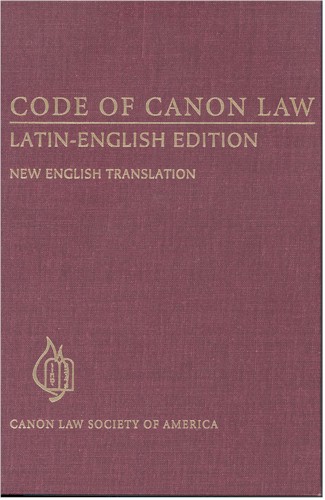
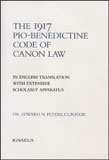
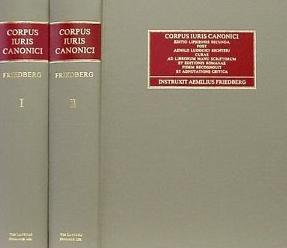
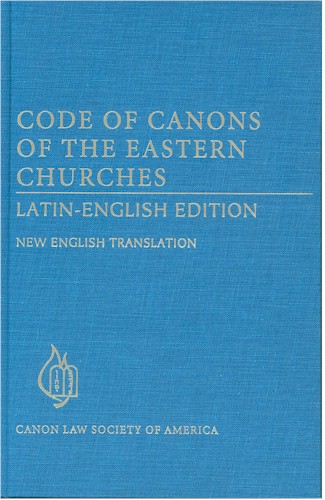
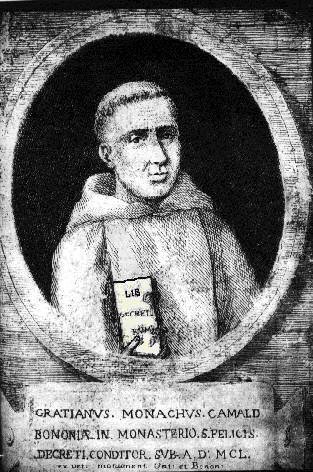 About Gratian himself (imagined to the left) we know little. Long thought to have been a Camaldolese monk who taught law in Bologna in the mid 12th century, he more likely wasn't and didn't. In any event, the publication around the year 1140 of Gratian's compilation and analysis of over 4,000 canonical provisions revolutionized canon law and established it as an ecclesiastical discipline (see 1983 CIC 252) independent from theology. Known to history as the
About Gratian himself (imagined to the left) we know little. Long thought to have been a Camaldolese monk who taught law in Bologna in the mid 12th century, he more likely wasn't and didn't. In any event, the publication around the year 1140 of Gratian's compilation and analysis of over 4,000 canonical provisions revolutionized canon law and established it as an ecclesiastical discipline (see 1983 CIC 252) independent from theology. Known to history as the 